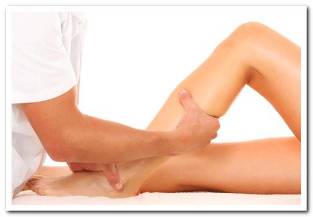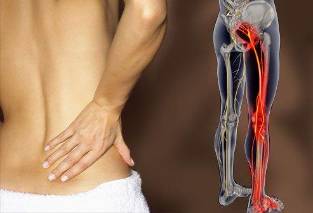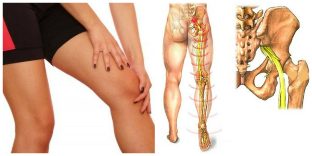This is the kind of pain bothers you, to not only live, but even just for a walk. How is it that the pain arising from the back can penetrate the limb, because it's lame? Although the source is much higher, we feel the effect of the distance: back hurting, but numb, and then drag the leg. The pain radiates to the leg?

Causing radiating pain in the legs can be draft, low back pain, hernia, cancer, stress
This is due to a reflex nervous nature of the pain, the ability to spread the full length of the picture unfolds in the spinal cord. If this nerve somewhere is irritated, there is a remote response.
One of the possible causes of foot pain can be inflammation of the sciatic nerve
The lumbosacralis plexus of nerve fibers emerging from the vertebrae l4, L5, and S1 — S3. This plexus is called the sciatic nerve. From the comfort of your piriformis, it literally divides the thigh, ankle muscles, joints, the strongest longest image of the human body.
Sciatica react, thus the lower extremities. Pain in the lower back to the leg, the so-called lumbosciatica. Usually suffer (patient, or drag) one foot on the side of the nerve, but sometimes two-reaction, in which both my legs hurt.
The pain is not limited to, the patient harassment, or other unpleasant feelings:
- Kolya's feet, lose sensitivity, drag, or numbness
If the nerve is affected at the level of the sacrum, through the muscles of the buttocks, the thighs, the pain syndrome, the sacrum, the leg, called sciatica.
Very often people feel pain in the back, legs, in two different categories, I don't see the reason. "It hurts right knee, numb foot. I can't go on foot to climb the stairs" — describe in detail the position of the limbs, forgetting about the pain in the back, which preceded it. I was surprised by the "incompetence" of the doctor, who, instead of treating knee osteoarthritis, suddenly begins to engage the spine.
But it's the spine to the complex nervous system, muscle -, tendon -, and the circulatory system is the underlying cause of the sciatica.
Why is it sick, pull and numb feet
- Normal draft can be, because it's the lumbago in the lower back, radiating to leg. The same consequences can cause sitting on the cold surface swimming in cold water, for similar reasons. Both qualify for the term "hypothermia"
- Osteochondrosis — dystrophic degenerative process of the lumbosacralis in the region on a regular basis leads to sharp pain, radiating to the extremities. The deformation of the disc touching the nerve, which causes inflammation
- The formation of the protrusion, herniated disks can cause pain syndrome is very high intensity, if compressed picture. Pain impulse is distributed in the area of innervation of the speed of the current. I'm curious, what's the feeling on the affected side is also similar to the symptoms of the weak current: Tingling, burning, full of skin full of cold feeling. These symptoms are called paresthesia. If the leg doesn't hurt anymore, numb, maybe that's because long-term compression, nerve fibers, they started to atrophic processes
- Other diseases (spondylitis, spondylosis, spondylolisthesis) leads to limitation and stagnation of the bone tissues, muscles, nerves, blood vessels, which stimulates the inflammatory processes
- Spinal tumors, and tuberculosis can also cause inflammation of the sciatic nerve, the feeling, that pulling, numbness in the extremities
- Stress is not a harmless phenomenon, but never goes unnoticed, especially where nerves are involved
Classification of the pain syndrome of the hind legs

Origin of all kinds of back pain radiating to the extremities, can be roughly defined in three main groups:
- The first group is associated with neuroreflex nature of the pain syndrome, as well as the pathological processes of the spine.
Here all the DDP (degenerative process), which violated all metabolic processes in the tissues of the diet, and infectious, inflammatory diseases, and congenital dysplasia of the spine. The threat to the nerve fibers here double:
- Exposed to direct mechanical effects to a part of the spine
- Degenerative changes begin to occur in the nerve fibers
- The second group is associated with muscle dysfunction in the back or the legs. Reason to other. This:
- Scoliosis of the spine, where it formed a permanent asymmetry in the muscle group located on both sides of the face
- An increased load on certain muscles due to uncomfortable body position or physical stress
- Muscle myositis caused by hypothermia, infectious processes or congenital abnormalities
- Leg pain often occurs very banal reason — walking in high heels Because of foot pain can be uncomfortable, high-heeled shoes
- Autonomic disorders — the third type of origin of sciatica
Vegetative-visceral disorders — this is a huge symptom, which includes all the diseases of the internal organs, and body systems related to impaired adjustment of the autonomic nervous system (ANS)
The autonomic system is closely linked to the Central principle of immediate feedback:
- Defects of the Central nervous system, the local damage to spinal nerves, and the fibers gives rise to the irregularities of the VNS
- The autonomic disturbances include the response of the nervous Central nervous system, in the area of innervation, which
Especially often problems with the feet, the autonomic vascular disorders in the area of the lumbosacralis spine. Poor blood supply can lead to pain in the hind limbs, muscle atrophy in the legs.
Summing up the above we can say:
To find out why he's sick, you pull on numb legs, because the pain was originally in the back, only after a thorough diagnosis:
- History
- X-ray, CT scan, magnetic resonance imaging of the spine
- Angiography of the
- Laboratory tests, etc.
The treatment of pain in the legs
The treatment is fully sufficient to cause of the disease.

- If the pain is generated by the MDC, is this:
- Analgesic, anti-inflammatory (Nsaids)
- Traction techniques (stretching of the spine by exhaust devices)
- Chiropractic, acupuncture
- The application of low-frequency currents, magnetic therapy, other physiotherapy methods hardware
- Exercises, physical therapy
- Muscular disorder caused by scoliosis, also apply:
- Special corrective exercises
- Wearing A corset
- Treatment of myositis is successfully carried out:
- Irritating ointments (if myositis is not caused by infection)
- Massage, physical therapy
- In some cases, you may need antibiotic therapy
- The dystonia prescribed complex treatment:
- Vasodilators
- Angioprotectors
- Vitamins, stimulants, metabolic processes
- Sedatives, hypnotics, tranquilizers
Treatment reflect pain is always a long process as usually occur in chronic, long-standing diseases that affect the human nervous system
Therefore, if a back pain, try to immediately determine the cause of the pain, and then start the treatment without waiting for the moment when it starts to hurt, insensitive, or drag the leg.
If the pain radiates to the leg, first of all think about lumbago (sciatica), or sciatica. Especially if your fingers numb pain in my leg. The most common case. Few remember that such symptoms can be other diseases, such as acute appendicitis.

Reason
- The most common cause of the pathology of the spine (osteochondrosis, scoliosis, radiculitis, sciatica, slipped disc, spondylitis, spondylolisthesis and other diseases of degenerative nature, as well as the post-traumatic complications, tumor, infection);
- The pathology of the organs of the lower abdomen (kidney stones, cystitis, oophoritis, adhesions, inguinal hernia, appendicitis, etc.).
Important: the rare diseases that the appearance of the described syndrome, we must not forget.
Pathology of bone, muscle structures
Pain in the lower back, associated with disease of the spine, which is the lower limb called lumbosciatica.
Degenerative process of the lumbar spine, the pain often develops because of the compression of a nerve root, radiating to the lower limbs is the main nerve of the lumbosacralis plexus, the hips, which is divided into fibula, tibia. The latter give the popliteal fossa causes, that the nerves of the lower leg.
Compression of nerve roots occurs when the destruction of inter-vertebral cartilage, the background of the degenerative reactions. This decreases the distance between the adjacent vertebrae, consequently, less openings in the spinal nerve roots. If the herniated disc, annoyed directly the protrusion of the hernia, tumors, abnormal tissue growths, while the spondylosis is bony overgrowths, called joints.
The background of the pathological process is always evolving inflammatory reaction in the form of edema, disruption of the surrounding tissues, worsening the blood circulation in the affected area, or inhibit the normal metabolism. Resulting increased muscle tone in the area of innervation of the roots of the disadvantaged, which leads to strengthening the pain.
The development of changes in the spine usually marked the end of the process the ossification of approximately 25 years is considered a normal physiological phenomenon. This is the premature aging of bones, cartilage structures may be suspended, if the principle of following the proper nutrition and strengthen the back muscles with special exercises.
The different nature of the pain syndrome
Diseases of the spine occur in the following types of sciatica:
- Error musculo-tonic — manifested a strong pungent cramps, while developing compensatory curvature of the spine, the movement of the lower back limited;
- Vegetative-vascular — pain, burning in nature accompanied by a feeling of numbness in the foot, you may have a feeling hot or cold in the extremities, especially if you try to change the position of the body. Forthcoming vascular system and pathological process;
- Neurodystrophic — evolving burning, cramping, especially at night, sometimes the skin above the pathological foci thinner.
Important: the most common pain syndrome joint. One form of sciatica in its pure form is rare.
Clinical manifestations of certain diseases of the spine
- When osteoarthritis pain can be acute or chronic. Acute pain occurs after sudden movements, or lifting heavy weights. Often numbness in both legs pain in the area of the hip bone, and movement of the lower back is severely limited.
The chronic pain is almost a constant companion of life, which is almost used as the lucid interval is very small. That's why drag in the lumbar region, and along the branches of the sciatic nerve.
- If the herniated disc, localized in the lumbar spine, pain can't be, but disturbed function of pelvic organs: often get "pee on the toilet", urinary incontinence may develop, it should be noted, the leg tingling, "needles".
The development of pain syndrome may develop paralysis of the lower limbs caused by full compression, the engine rootl moliets. But the more such, can have serious consequences, the pathological process is not managed.
- The sciatica, and lumbago in the lower back radiating to the leg, and lameness, muscle pain, and pull. You can reduce the sensitivity of the posterolateral surface of the leg, the back side of the leg. Relief comes in the supine position, the back should be relaxed. Sometimes the pain-syndrome, attenuated "the fetal position".
Pathology of the internal organs
Often low back pain radiating to the leg, or the manifestation of diseases of internal organs. Limb, as long as this number is, the nerves pull and the pain can also be given in the groin.
- Kidney stones obviously down syndrome, and when the stone passes through the ureter;
- And adhesive disease nerves also pressure spikes;
- Salpingoophoritis, uterine fibroids, endometriosis can also manifest as discomfort in the lumbosacralis segment of the leg on the affected side;
- Acute appendicitis with atypical location of the Appendix (retroperitoneal on the posterior surface of the cecum) pulling pain in right lumbar region, which shoots down my right leg. If the supine position, do not lift the straight right leg, and he involuntarily bent, and then to unfold out.
This phenomenon can be explained by the peculiarities of the innervation of the pelvic organs, limbs.





































